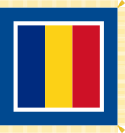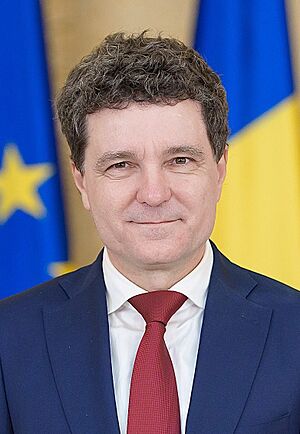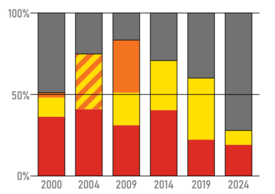President of Romania facts for kids
Quick facts for kids President of Romania |
|
|---|---|

|
|
| Style |
|
| Member of | Supreme Council of National Defence European Council |
| Residence | Cotroceni Palace |
| Appointer | Popular vote |
| Term length | Five years,
renewable once
|
| Constituting instrument | Constitution of Romania (1991) |
| Inaugural holder | Nicolae Ceaușescu (first established) Ion Iliescu (current constitution) |
| Formation | 28 March 1974 8 December 1991 (current form) |
| Deputy | President of the Senate |
| Salary | 324,000 lei annually (2015) |
| Website | Președintele României |
The president of Romania (Romanian: Președintele României) is the head of state of Romania. This means they are the main representative of the country. The president is chosen directly by the people through a special election system. They serve for five years and can be re-elected only once. While in office, the president cannot be a formal member of a political party. The president of Romania is also the supreme commander of the Romanian Armed Forces, leading the country's military.
The role of president was created in 1974. At that time, Nicolae Ceaușescu, the leader of the Romanian Communist Party, made the position more powerful. After the Romanian Revolution, the office changed to its current form, which was set by Romania's Constitution in 1991.
Nicușor Dan is the 6th and current president of Romania. He started his term on May 26, 2025.
Contents
How the President's Role Began
The Communist Era
During the time when Romania was a communist country, the president was elected for a five-year term. This election was done by the Great National Assembly, which was like the parliament. The leader of the Romanian Communist Party, Nicolae Ceaușescu, was the only person to hold this office during that period. He was elected in 1974 and re-elected twice, always without anyone running against him.
Ceaușescu created this position to become the main decision-maker in the country. Before this, he was just one of several leaders. By becoming president, he gained more direct power. He could make many decisions on his own, even without the full approval of other government bodies.
Becoming President: The Oath
After the election results are confirmed, the new president takes an important oath. This happens when both houses of the Parliament meet together. The oath is a promise to serve the country and its people.
The president says: Romanian: Jur să-mi dăruiesc toată puterea și priceperea pentru propășirea spirituală și materială a poporului român, să respect Constituția și legile țării, să apăr democrația, drepturile și libertățile fundamentale ale cetățenilor, suveranitatea, independența, unitatea și integritatea teritorială a României. Așa să-mi ajute Dumnezeu!
This means: I solemnly swear that I will dedicate all my strength and the best of my ability to the spiritual and material welfare of the Romanian people, to abide by the Constitution and laws of the country, to defend democracy, the fundamental rights and freedoms of my fellow-citizens, Romania's sovereignty, independence, unity and territorial integrity. So help me God!
What the President Does
The president has many important jobs and powers, as outlined in the Constitution. Even though their powers are not as broad as during the communist era, the president still has a lot of influence in Romania's government system.
Duties Inside Romania
- Represents the State: The president is the symbol of Romania and protects its independence and unity.
- Upholds the Constitution: They make sure the country's main laws are followed and that public authorities work correctly.
- Appoints the Prime Minister: The president chooses the prime minister, but Parliament must approve this choice. The president cannot fire the prime minister.
- Appoints Ministers: They appoint and remove other government ministers based on the prime minister's advice.
- Leads Important Meetings: The president can lead government meetings when big issues about foreign policy, national defense, or public order are discussed.
- Speaks to Parliament: They can talk to Parliament about important national topics.
- Approves Laws: The president must approve new laws passed by Parliament. They can ask Parliament to rethink a law once.
- Calls Elections and Sessions: They call Parliament together after elections and can ask for special meetings.
- Can Dissolve Parliament: In certain situations, if a government cannot be formed, the president can dissolve Parliament, leading to new elections.
- Calls Referendums: The president can ask the public to vote on important issues through a referendum, after talking with Parliament.
Duties in Foreign Affairs
- Travels Overseas: The president makes official visits to other countries.
- Signs Treaties: They sign international agreements that the government has negotiated.
- Appoints Ambassadors: The president chooses and recalls ambassadors and other diplomats who represent Romania in other countries.
- Welcomes Foreign Diplomats: They receive official papers from foreign diplomats coming to Romania.
Duties in Defense
- Commander-in-Chief: The president is the top leader of the Armed Forces.
- Leads Defense Council: They lead the Supreme Council of National Defence, which plans the country's security.
- Declares Mobilization: They can order the military to prepare for action, usually with Parliament's approval.
- Responds to Attacks: The president acts to defend the country if it is attacked.
- Declares Emergency: They can declare a state of siege or emergency in the country or a part of it, with Parliament's later approval.
Other Important Duties
- Gives Awards: The president gives out special awards and honors.
- Appoints Military Leaders: They appoint people to high ranks in the military.
- Appoints Public Officials: They make appointments to other public jobs as required by law.
- Grants Pardons: The president can forgive people who have committed certain crimes.
Removing the President from Office
If a president seriously breaks the Constitution, the Parliament can vote to suspend them. If this vote passes, the public then votes in a special referendum to decide if the president should be removed from office. This vote must happen within 30 days.
If both houses of Parliament accuse the president of a very serious betrayal of the country, the president is immediately suspended. A special court, the High Court of Cassation and Justice, then judges the accusations. If the president is found guilty, they are removed from office right away.
Past Attempts to Remove Presidents
There have been three times when the process to suspend or remove a president was started:
- 1995: An attempt to suspend President Ion Iliescu did not pass in Parliament.
- 2007: President Traian Băsescu was suspended by Parliament. A public vote was held on May 19, 2007. However, the people voted against removing him, and he stayed in office.
- 2012: Again, President Traian Băsescu was suspended by Parliament. A referendum was held on July 29, 2012. Most people voted to remove him, but not enough people participated in the vote for it to be valid. So, the Constitutional Court said the vote was invalid, and Băsescu remained president.
In February 2025, Klaus Iohannis resigned as President to avoid dividing Romania.
Who Takes Over if the President Can't Serve?
If the president's office becomes empty because of resignation, removal, inability to do the job, or death, the president of the Senate becomes the acting president. If the Senate president's job is also empty, then the president of the Chamber of Deputies becomes the acting president.
The acting president does not have to give up their role as head of their legislative house. However, an acting president has limited powers. They cannot speak to Parliament, dissolve Parliament, or call for a public referendum (except for the impeachment referendum if Parliament calls for it). The office cannot be empty for more than three months. If the president is only suspended, the office is not considered empty.
Latest Election Results
| Candidate | Party | First round | Second round | |||
|---|---|---|---|---|---|---|
| Votes | % | Votes | % | |||
| George Simion | Alliance for the Union of Romanians | 3,862,761 | 40.96 | 5,339,053 | 46.40 | |
| Nicușor Dan | Independent | 1,979,767 | 20.99 | 6,168,642 | 53.60 | |
| Crin Antonescu | Romania Forward Electoral Alliance | 1,892,930 | 20.07 | |||
| Victor Ponta | Independent | 1,230,164 | 13.04 | |||
| Elena Lasconi | Save Romania Union | 252,721 | 2.68 | |||
| Lavinia Șandru | Social Liberal Humanist Party | 60,682 | 0.64 | |||
| Daniel Funeriu | Independent | 49,604 | 0.53 | |||
| Cristian Terheș | Romanian National Conservative Party | 36,445 | 0.39 | |||
| Sebastian Popescu | New Romania Party | 25,994 | 0.28 | |||
| John Ion Banu | Independent | 22,020 | 0.23 | |||
| Silviu Predoiu | National Action League Party | 17,186 | 0.18 | |||
| Total | 9,430,274 | 100.00 | 11,507,695 | 100.00 | ||
| Valid votes | 9,430,274 | 98.52 | 11,507,695 | 98.85 | ||
| Invalid/blank votes | 141,466 | 1.48 | 134,171 | 1.15 | ||
| Total votes | 9,571,740 | 100.00 | 11,641,866 | 100.00 | ||
| Registered voters/turnout | 17,988,031 | 53.21 | 17,988,218 | 64.72 | ||
| Source: Permanent Electoral Authority | ||||||
See Also
External Links
- Official site of the Romanian presidency: http://www.presidency.ro
cy:Rhestr Arlywyddion Rwmania fr:Chefs d'État roumains it:Capi di Stato della Romania



